Essay: The Doctrine of Precedent's Adverse Effects on English Law
VerifiedAdded on 2022/08/26
|7
|1689
|23
Essay
AI Summary
This essay critically examines the doctrine of precedent and its influence on the English legal system. It begins by defining precedent, emphasizing its role in providing legal certainty and the hierarchical structure of the court system, and introduces key concepts like ratio decidendi and obiter dicta. The essay then discusses the different types of precedent, including original and persuasive precedents, and how they function within the court hierarchy, referencing cases such as Donoghue v. Stevenson and Carlill v. Carbolic Smoke Ball Co Ltd. The analysis includes a discussion of the House of Lords' role and how it has evolved over time. The essay also addresses situations where judges may avoid following precedent, providing examples like Balfour v. Balfour and Merritt v. Merritt. Ultimately, the essay argues that while the doctrine of precedent is a crucial component of the English legal system, it can have adverse effects, and concludes by acknowledging efforts to accommodate social changes.
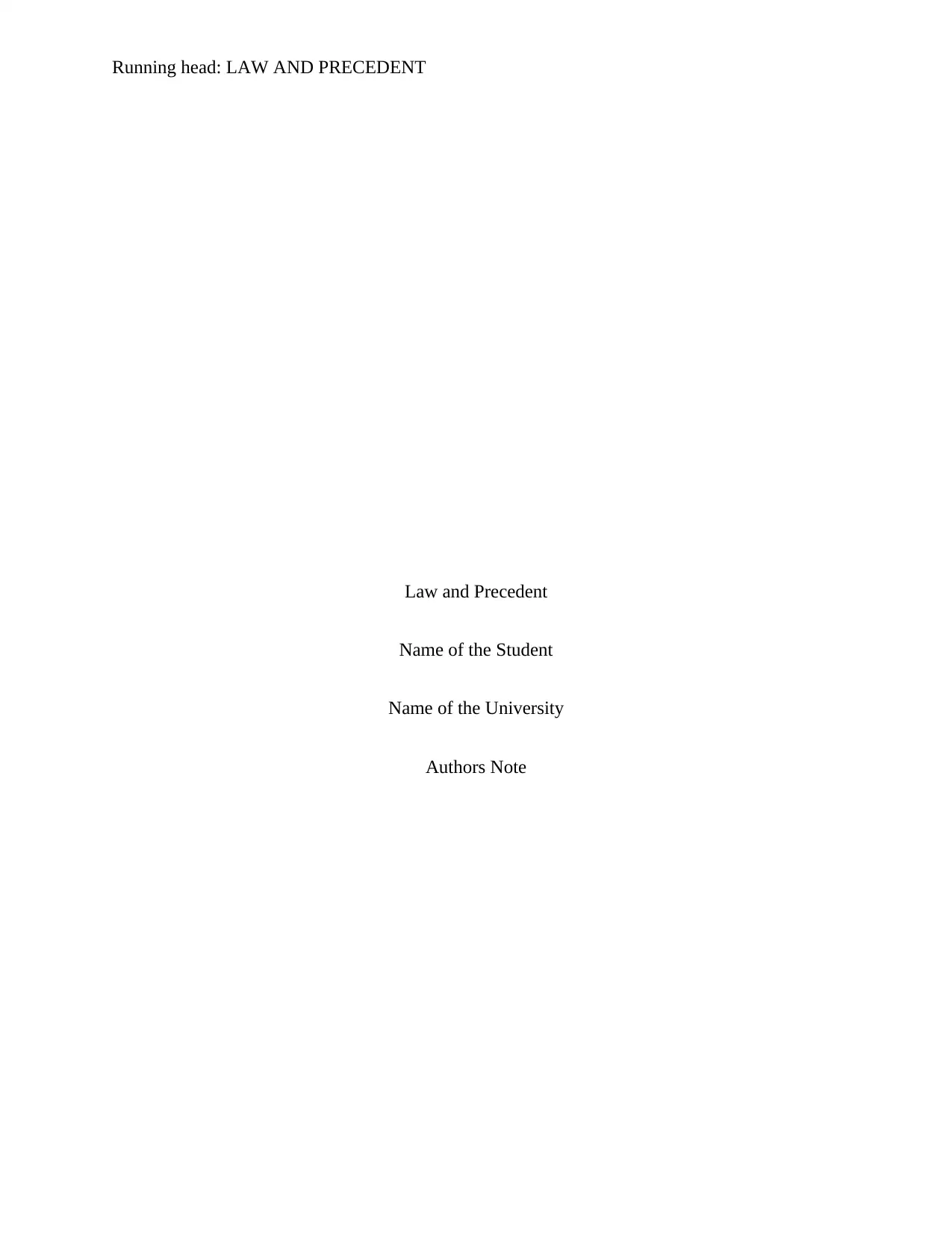
Running head: LAW AND PRECEDENT
Law and Precedent
Name of the Student
Name of the University
Authors Note
Law and Precedent
Name of the Student
Name of the University
Authors Note
Paraphrase This Document
Need a fresh take? Get an instant paraphrase of this document with our AI Paraphraser
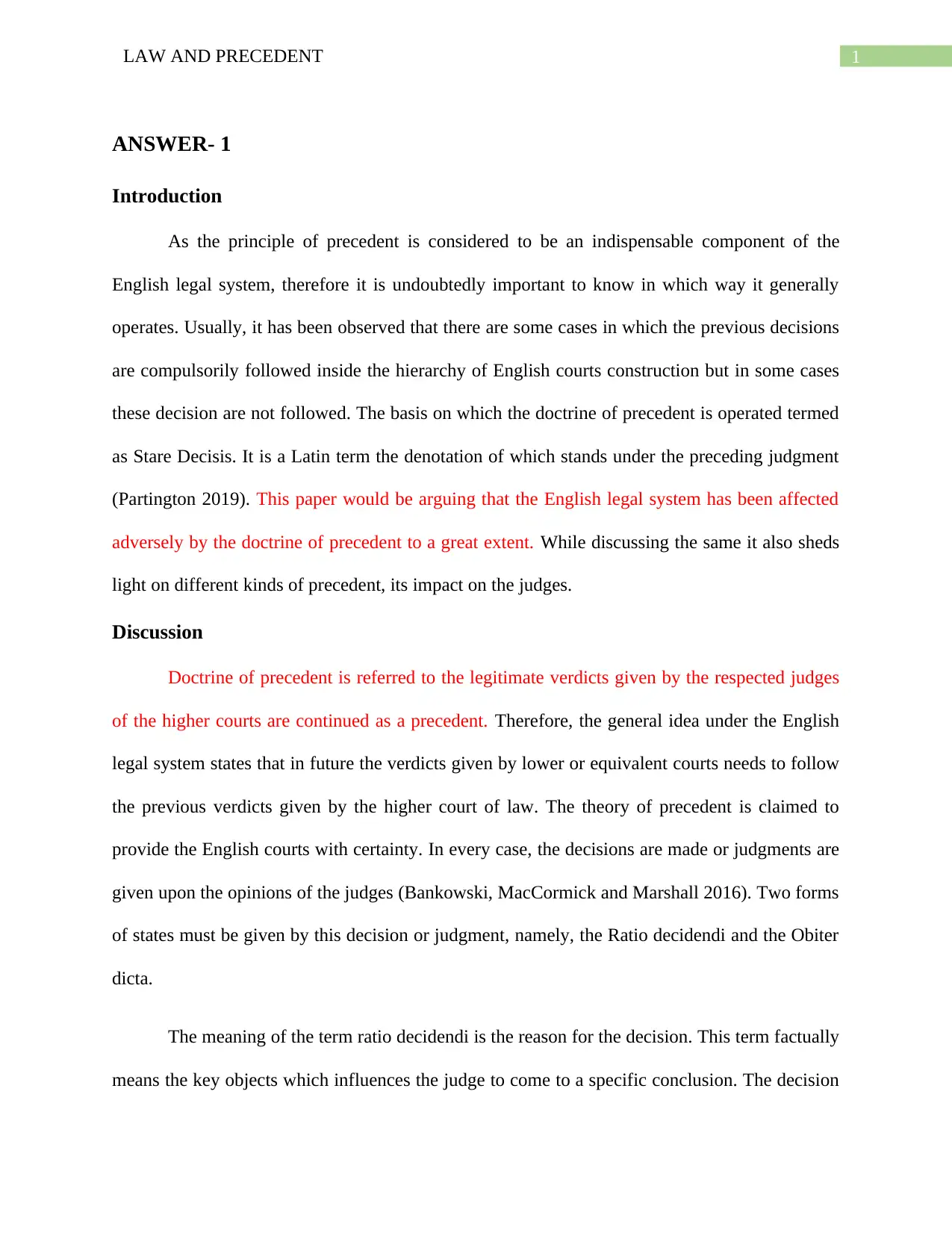
1LAW AND PRECEDENT
ANSWER- 1
Introduction
As the principle of precedent is considered to be an indispensable component of the
English legal system, therefore it is undoubtedly important to know in which way it generally
operates. Usually, it has been observed that there are some cases in which the previous decisions
are compulsorily followed inside the hierarchy of English courts construction but in some cases
these decision are not followed. The basis on which the doctrine of precedent is operated termed
as Stare Decisis. It is a Latin term the denotation of which stands under the preceding judgment
(Partington 2019). This paper would be arguing that the English legal system has been affected
adversely by the doctrine of precedent to a great extent. While discussing the same it also sheds
light on different kinds of precedent, its impact on the judges.
Discussion
Doctrine of precedent is referred to the legitimate verdicts given by the respected judges
of the higher courts are continued as a precedent. Therefore, the general idea under the English
legal system states that in future the verdicts given by lower or equivalent courts needs to follow
the previous verdicts given by the higher court of law. The theory of precedent is claimed to
provide the English courts with certainty. In every case, the decisions are made or judgments are
given upon the opinions of the judges (Bankowski, MacCormick and Marshall 2016). Two forms
of states must be given by this decision or judgment, namely, the Ratio decidendi and the Obiter
dicta.
The meaning of the term ratio decidendi is the reason for the decision. This term factually
means the key objects which influences the judge to come to a specific conclusion. The decision
ANSWER- 1
Introduction
As the principle of precedent is considered to be an indispensable component of the
English legal system, therefore it is undoubtedly important to know in which way it generally
operates. Usually, it has been observed that there are some cases in which the previous decisions
are compulsorily followed inside the hierarchy of English courts construction but in some cases
these decision are not followed. The basis on which the doctrine of precedent is operated termed
as Stare Decisis. It is a Latin term the denotation of which stands under the preceding judgment
(Partington 2019). This paper would be arguing that the English legal system has been affected
adversely by the doctrine of precedent to a great extent. While discussing the same it also sheds
light on different kinds of precedent, its impact on the judges.
Discussion
Doctrine of precedent is referred to the legitimate verdicts given by the respected judges
of the higher courts are continued as a precedent. Therefore, the general idea under the English
legal system states that in future the verdicts given by lower or equivalent courts needs to follow
the previous verdicts given by the higher court of law. The theory of precedent is claimed to
provide the English courts with certainty. In every case, the decisions are made or judgments are
given upon the opinions of the judges (Bankowski, MacCormick and Marshall 2016). Two forms
of states must be given by this decision or judgment, namely, the Ratio decidendi and the Obiter
dicta.
The meaning of the term ratio decidendi is the reason for the decision. This term factually
means the key objects which influences the judge to come to a specific conclusion. The decision
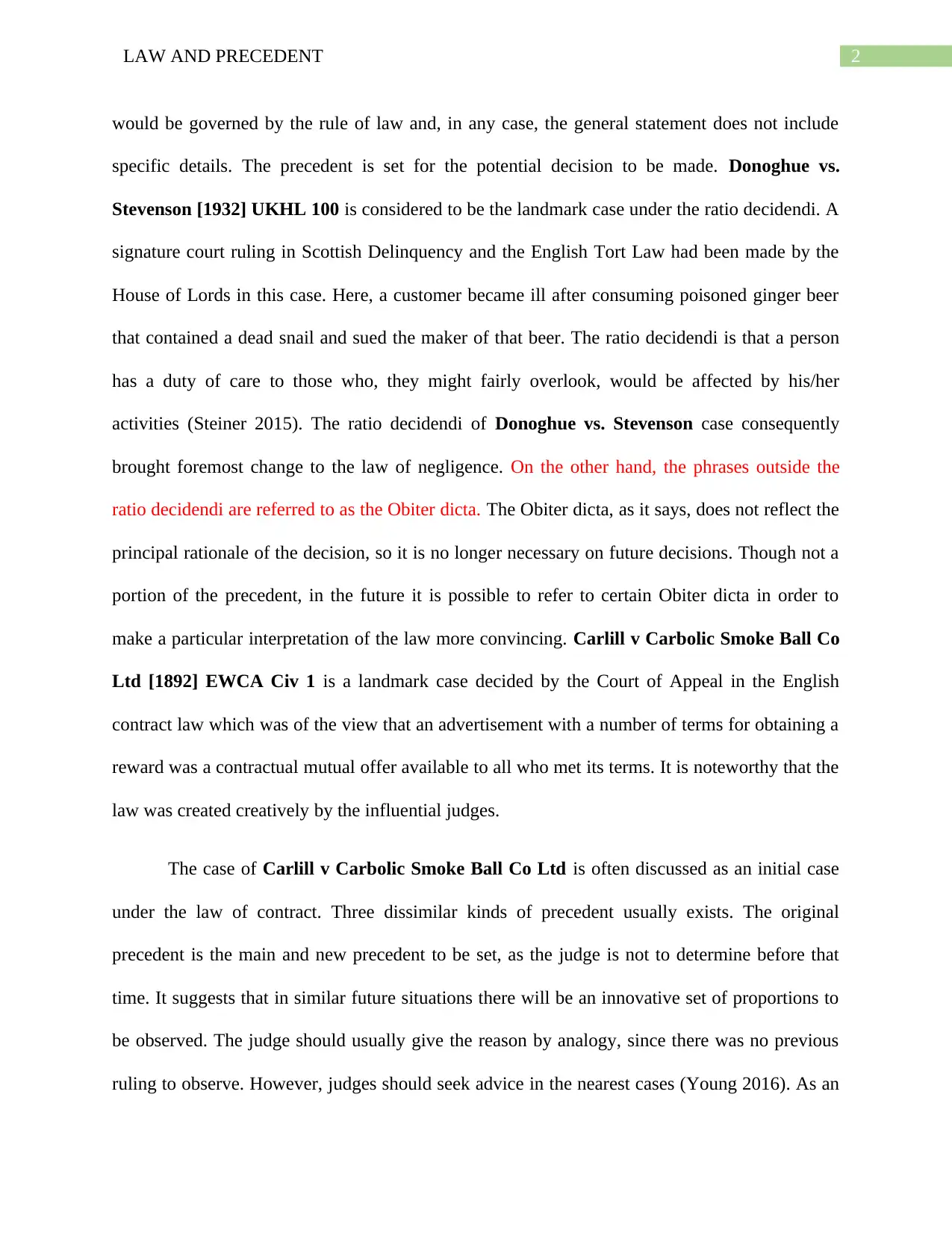
2LAW AND PRECEDENT
would be governed by the rule of law and, in any case, the general statement does not include
specific details. The precedent is set for the potential decision to be made. Donoghue vs.
Stevenson [1932] UKHL 100 is considered to be the landmark case under the ratio decidendi. A
signature court ruling in Scottish Delinquency and the English Tort Law had been made by the
House of Lords in this case. Here, a customer became ill after consuming poisoned ginger beer
that contained a dead snail and sued the maker of that beer. The ratio decidendi is that a person
has a duty of care to those who, they might fairly overlook, would be affected by his/her
activities (Steiner 2015). The ratio decidendi of Donoghue vs. Stevenson case consequently
brought foremost change to the law of negligence. On the other hand, the phrases outside the
ratio decidendi are referred to as the Obiter dicta. The Obiter dicta, as it says, does not reflect the
principal rationale of the decision, so it is no longer necessary on future decisions. Though not a
portion of the precedent, in the future it is possible to refer to certain Obiter dicta in order to
make a particular interpretation of the law more convincing. Carlill v Carbolic Smoke Ball Co
Ltd [1892] EWCA Civ 1 is a landmark case decided by the Court of Appeal in the English
contract law which was of the view that an advertisement with a number of terms for obtaining a
reward was a contractual mutual offer available to all who met its terms. It is noteworthy that the
law was created creatively by the influential judges.
The case of Carlill v Carbolic Smoke Ball Co Ltd is often discussed as an initial case
under the law of contract. Three dissimilar kinds of precedent usually exists. The original
precedent is the main and new precedent to be set, as the judge is not to determine before that
time. It suggests that in similar future situations there will be an innovative set of proportions to
be observed. The judge should usually give the reason by analogy, since there was no previous
ruling to observe. However, judges should seek advice in the nearest cases (Young 2016). As an
would be governed by the rule of law and, in any case, the general statement does not include
specific details. The precedent is set for the potential decision to be made. Donoghue vs.
Stevenson [1932] UKHL 100 is considered to be the landmark case under the ratio decidendi. A
signature court ruling in Scottish Delinquency and the English Tort Law had been made by the
House of Lords in this case. Here, a customer became ill after consuming poisoned ginger beer
that contained a dead snail and sued the maker of that beer. The ratio decidendi is that a person
has a duty of care to those who, they might fairly overlook, would be affected by his/her
activities (Steiner 2015). The ratio decidendi of Donoghue vs. Stevenson case consequently
brought foremost change to the law of negligence. On the other hand, the phrases outside the
ratio decidendi are referred to as the Obiter dicta. The Obiter dicta, as it says, does not reflect the
principal rationale of the decision, so it is no longer necessary on future decisions. Though not a
portion of the precedent, in the future it is possible to refer to certain Obiter dicta in order to
make a particular interpretation of the law more convincing. Carlill v Carbolic Smoke Ball Co
Ltd [1892] EWCA Civ 1 is a landmark case decided by the Court of Appeal in the English
contract law which was of the view that an advertisement with a number of terms for obtaining a
reward was a contractual mutual offer available to all who met its terms. It is noteworthy that the
law was created creatively by the influential judges.
The case of Carlill v Carbolic Smoke Ball Co Ltd is often discussed as an initial case
under the law of contract. Three dissimilar kinds of precedent usually exists. The original
precedent is the main and new precedent to be set, as the judge is not to determine before that
time. It suggests that in similar future situations there will be an innovative set of proportions to
be observed. The judge should usually give the reason by analogy, since there was no previous
ruling to observe. However, judges should seek advice in the nearest cases (Young 2016). As an
⊘ This is a preview!⊘
Do you want full access?
Subscribe today to unlock all pages.

Trusted by 1+ million students worldwide
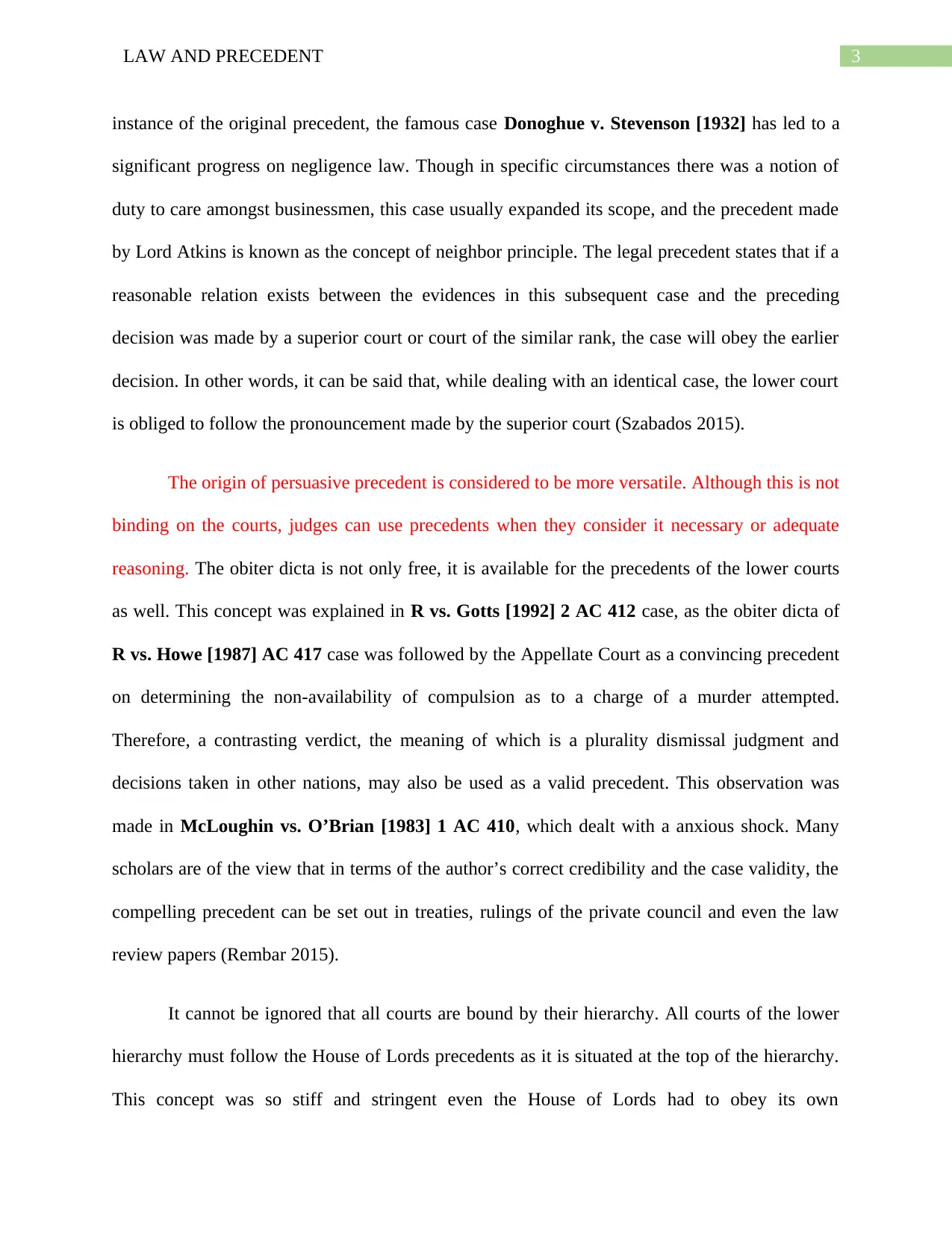
3LAW AND PRECEDENT
instance of the original precedent, the famous case Donoghue v. Stevenson [1932] has led to a
significant progress on negligence law. Though in specific circumstances there was a notion of
duty to care amongst businessmen, this case usually expanded its scope, and the precedent made
by Lord Atkins is known as the concept of neighbor principle. The legal precedent states that if a
reasonable relation exists between the evidences in this subsequent case and the preceding
decision was made by a superior court or court of the similar rank, the case will obey the earlier
decision. In other words, it can be said that, while dealing with an identical case, the lower court
is obliged to follow the pronouncement made by the superior court (Szabados 2015).
The origin of persuasive precedent is considered to be more versatile. Although this is not
binding on the courts, judges can use precedents when they consider it necessary or adequate
reasoning. The obiter dicta is not only free, it is available for the precedents of the lower courts
as well. This concept was explained in R vs. Gotts [1992] 2 AC 412 case, as the obiter dicta of
R vs. Howe [1987] AC 417 case was followed by the Appellate Court as a convincing precedent
on determining the non-availability of compulsion as to a charge of a murder attempted.
Therefore, a contrasting verdict, the meaning of which is a plurality dismissal judgment and
decisions taken in other nations, may also be used as a valid precedent. This observation was
made in McLoughin vs. O’Brian [1983] 1 AC 410, which dealt with a anxious shock. Many
scholars are of the view that in terms of the author’s correct credibility and the case validity, the
compelling precedent can be set out in treaties, rulings of the private council and even the law
review papers (Rembar 2015).
It cannot be ignored that all courts are bound by their hierarchy. All courts of the lower
hierarchy must follow the House of Lords precedents as it is situated at the top of the hierarchy.
This concept was so stiff and stringent even the House of Lords had to obey its own
instance of the original precedent, the famous case Donoghue v. Stevenson [1932] has led to a
significant progress on negligence law. Though in specific circumstances there was a notion of
duty to care amongst businessmen, this case usually expanded its scope, and the precedent made
by Lord Atkins is known as the concept of neighbor principle. The legal precedent states that if a
reasonable relation exists between the evidences in this subsequent case and the preceding
decision was made by a superior court or court of the similar rank, the case will obey the earlier
decision. In other words, it can be said that, while dealing with an identical case, the lower court
is obliged to follow the pronouncement made by the superior court (Szabados 2015).
The origin of persuasive precedent is considered to be more versatile. Although this is not
binding on the courts, judges can use precedents when they consider it necessary or adequate
reasoning. The obiter dicta is not only free, it is available for the precedents of the lower courts
as well. This concept was explained in R vs. Gotts [1992] 2 AC 412 case, as the obiter dicta of
R vs. Howe [1987] AC 417 case was followed by the Appellate Court as a convincing precedent
on determining the non-availability of compulsion as to a charge of a murder attempted.
Therefore, a contrasting verdict, the meaning of which is a plurality dismissal judgment and
decisions taken in other nations, may also be used as a valid precedent. This observation was
made in McLoughin vs. O’Brian [1983] 1 AC 410, which dealt with a anxious shock. Many
scholars are of the view that in terms of the author’s correct credibility and the case validity, the
compelling precedent can be set out in treaties, rulings of the private council and even the law
review papers (Rembar 2015).
It cannot be ignored that all courts are bound by their hierarchy. All courts of the lower
hierarchy must follow the House of Lords precedents as it is situated at the top of the hierarchy.
This concept was so stiff and stringent even the House of Lords had to obey its own
Paraphrase This Document
Need a fresh take? Get an instant paraphrase of this document with our AI Paraphraser
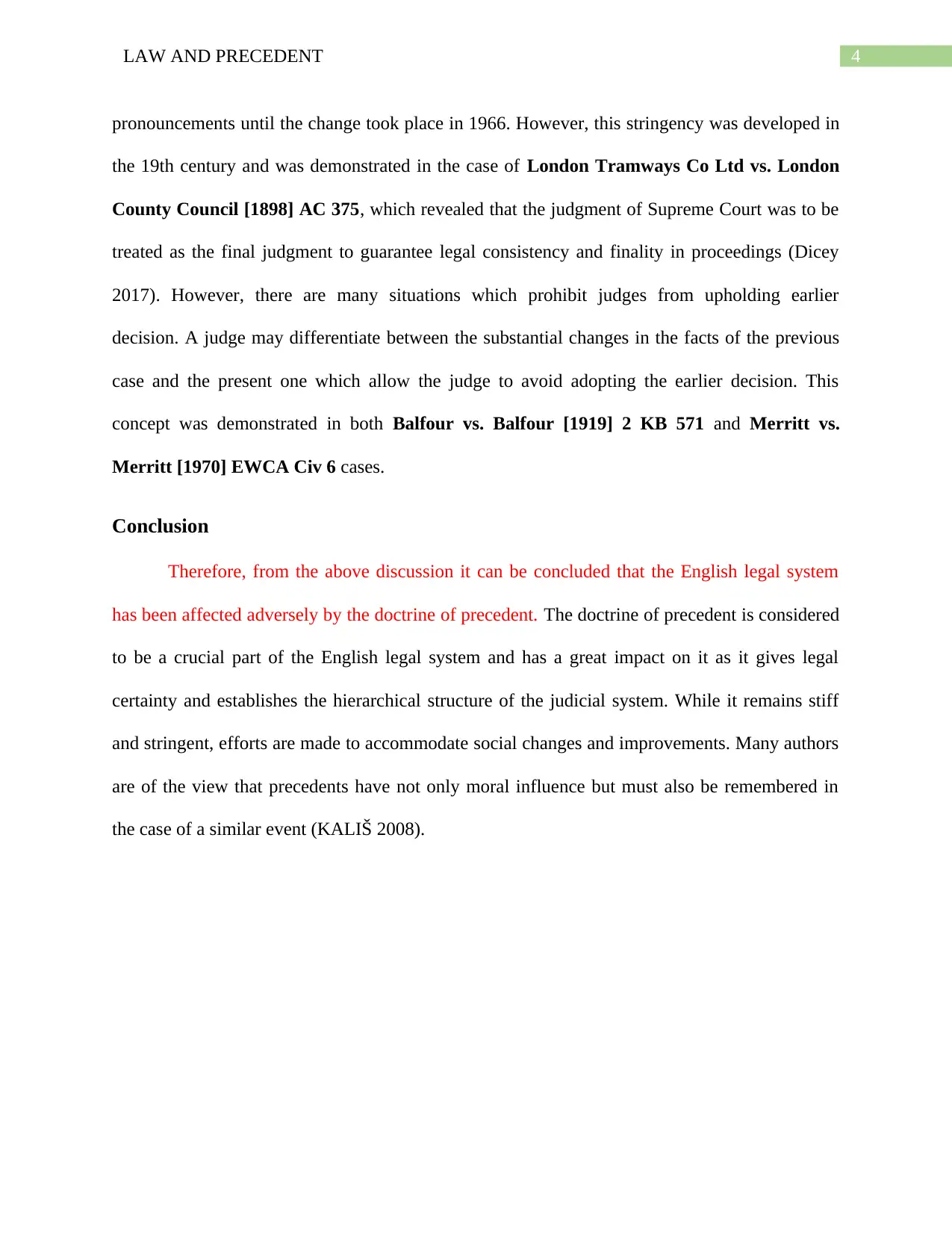
4LAW AND PRECEDENT
pronouncements until the change took place in 1966. However, this stringency was developed in
the 19th century and was demonstrated in the case of London Tramways Co Ltd vs. London
County Council [1898] AC 375, which revealed that the judgment of Supreme Court was to be
treated as the final judgment to guarantee legal consistency and finality in proceedings (Dicey
2017). However, there are many situations which prohibit judges from upholding earlier
decision. A judge may differentiate between the substantial changes in the facts of the previous
case and the present one which allow the judge to avoid adopting the earlier decision. This
concept was demonstrated in both Balfour vs. Balfour [1919] 2 KB 571 and Merritt vs.
Merritt [1970] EWCA Civ 6 cases.
Conclusion
Therefore, from the above discussion it can be concluded that the English legal system
has been affected adversely by the doctrine of precedent. The doctrine of precedent is considered
to be a crucial part of the English legal system and has a great impact on it as it gives legal
certainty and establishes the hierarchical structure of the judicial system. While it remains stiff
and stringent, efforts are made to accommodate social changes and improvements. Many authors
are of the view that precedents have not only moral influence but must also be remembered in
the case of a similar event (KALIŠ 2008).
pronouncements until the change took place in 1966. However, this stringency was developed in
the 19th century and was demonstrated in the case of London Tramways Co Ltd vs. London
County Council [1898] AC 375, which revealed that the judgment of Supreme Court was to be
treated as the final judgment to guarantee legal consistency and finality in proceedings (Dicey
2017). However, there are many situations which prohibit judges from upholding earlier
decision. A judge may differentiate between the substantial changes in the facts of the previous
case and the present one which allow the judge to avoid adopting the earlier decision. This
concept was demonstrated in both Balfour vs. Balfour [1919] 2 KB 571 and Merritt vs.
Merritt [1970] EWCA Civ 6 cases.
Conclusion
Therefore, from the above discussion it can be concluded that the English legal system
has been affected adversely by the doctrine of precedent. The doctrine of precedent is considered
to be a crucial part of the English legal system and has a great impact on it as it gives legal
certainty and establishes the hierarchical structure of the judicial system. While it remains stiff
and stringent, efforts are made to accommodate social changes and improvements. Many authors
are of the view that precedents have not only moral influence but must also be remembered in
the case of a similar event (KALIŠ 2008).
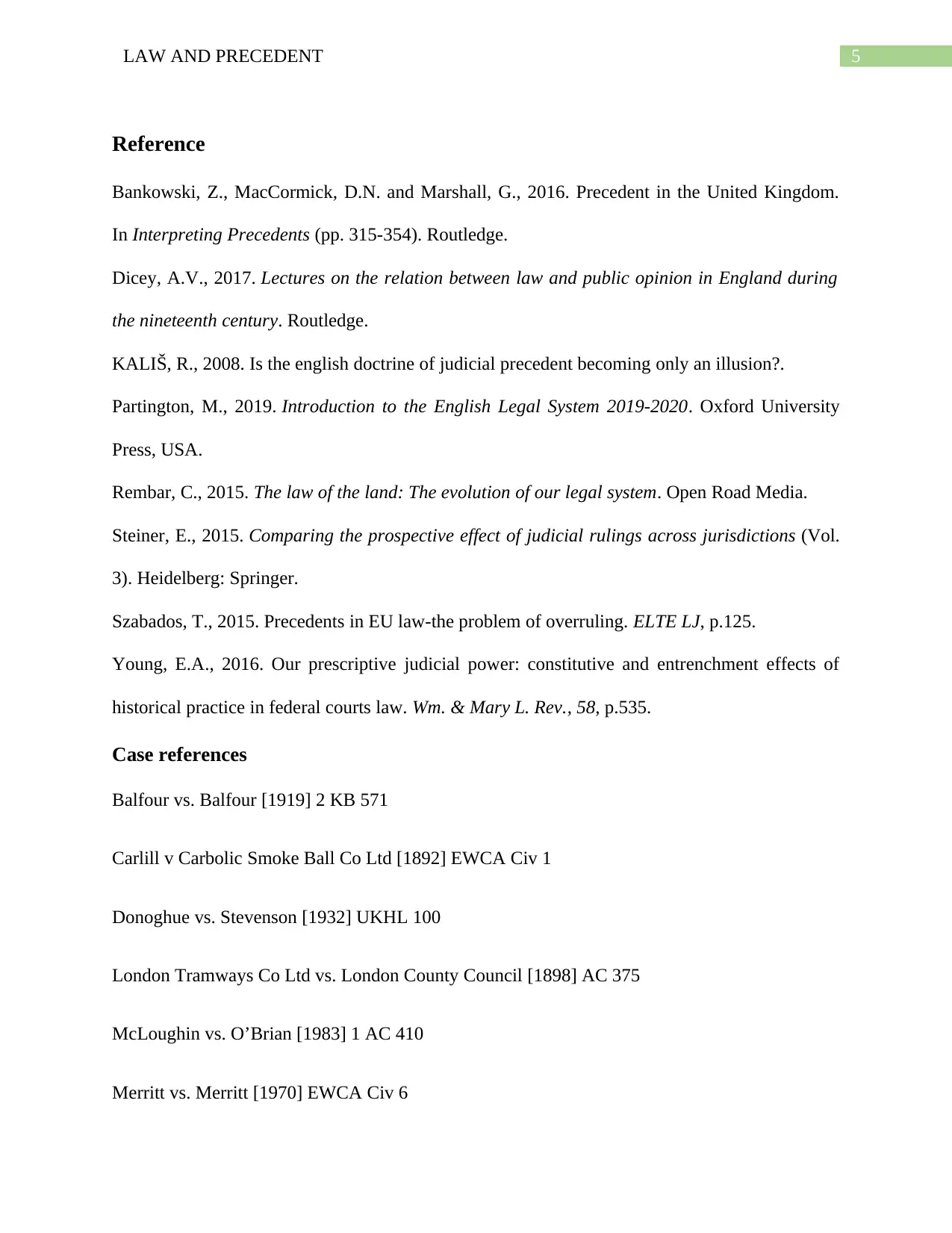
5LAW AND PRECEDENT
Reference
Bankowski, Z., MacCormick, D.N. and Marshall, G., 2016. Precedent in the United Kingdom.
In Interpreting Precedents (pp. 315-354). Routledge.
Dicey, A.V., 2017. Lectures on the relation between law and public opinion in England during
the nineteenth century. Routledge.
KALIŠ, R., 2008. Is the english doctrine of judicial precedent becoming only an illusion?.
Partington, M., 2019. Introduction to the English Legal System 2019-2020. Oxford University
Press, USA.
Rembar, C., 2015. The law of the land: The evolution of our legal system. Open Road Media.
Steiner, E., 2015. Comparing the prospective effect of judicial rulings across jurisdictions (Vol.
3). Heidelberg: Springer.
Szabados, T., 2015. Precedents in EU law-the problem of overruling. ELTE LJ, p.125.
Young, E.A., 2016. Our prescriptive judicial power: constitutive and entrenchment effects of
historical practice in federal courts law. Wm. & Mary L. Rev., 58, p.535.
Case references
Balfour vs. Balfour [1919] 2 KB 571
Carlill v Carbolic Smoke Ball Co Ltd [1892] EWCA Civ 1
Donoghue vs. Stevenson [1932] UKHL 100
London Tramways Co Ltd vs. London County Council [1898] AC 375
McLoughin vs. O’Brian [1983] 1 AC 410
Merritt vs. Merritt [1970] EWCA Civ 6
Reference
Bankowski, Z., MacCormick, D.N. and Marshall, G., 2016. Precedent in the United Kingdom.
In Interpreting Precedents (pp. 315-354). Routledge.
Dicey, A.V., 2017. Lectures on the relation between law and public opinion in England during
the nineteenth century. Routledge.
KALIŠ, R., 2008. Is the english doctrine of judicial precedent becoming only an illusion?.
Partington, M., 2019. Introduction to the English Legal System 2019-2020. Oxford University
Press, USA.
Rembar, C., 2015. The law of the land: The evolution of our legal system. Open Road Media.
Steiner, E., 2015. Comparing the prospective effect of judicial rulings across jurisdictions (Vol.
3). Heidelberg: Springer.
Szabados, T., 2015. Precedents in EU law-the problem of overruling. ELTE LJ, p.125.
Young, E.A., 2016. Our prescriptive judicial power: constitutive and entrenchment effects of
historical practice in federal courts law. Wm. & Mary L. Rev., 58, p.535.
Case references
Balfour vs. Balfour [1919] 2 KB 571
Carlill v Carbolic Smoke Ball Co Ltd [1892] EWCA Civ 1
Donoghue vs. Stevenson [1932] UKHL 100
London Tramways Co Ltd vs. London County Council [1898] AC 375
McLoughin vs. O’Brian [1983] 1 AC 410
Merritt vs. Merritt [1970] EWCA Civ 6
⊘ This is a preview!⊘
Do you want full access?
Subscribe today to unlock all pages.

Trusted by 1+ million students worldwide
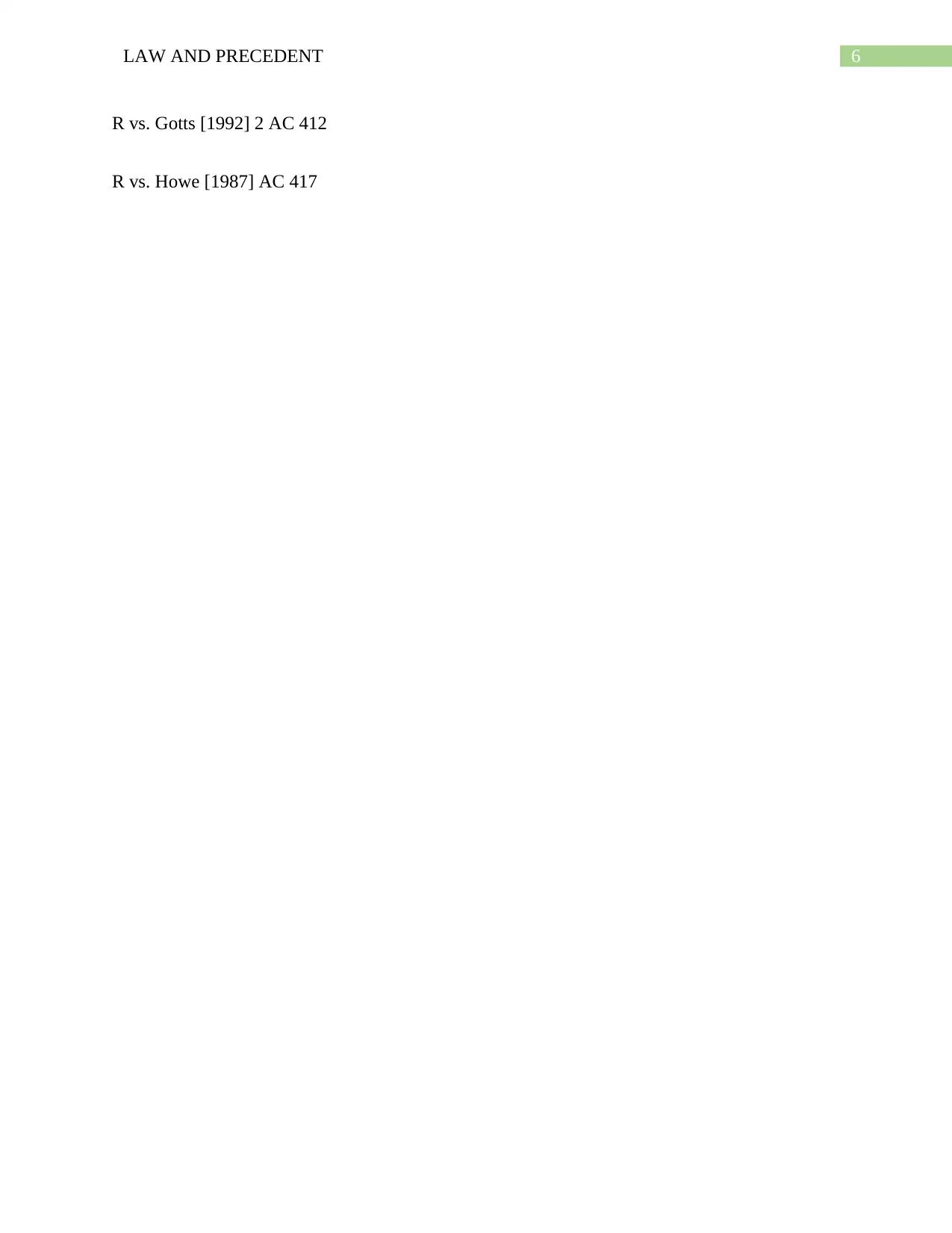
6LAW AND PRECEDENT
R vs. Gotts [1992] 2 AC 412
R vs. Howe [1987] AC 417
R vs. Gotts [1992] 2 AC 412
R vs. Howe [1987] AC 417
1 out of 7
Related Documents
Your All-in-One AI-Powered Toolkit for Academic Success.
+13062052269
info@desklib.com
Available 24*7 on WhatsApp / Email
![[object Object]](/_next/static/media/star-bottom.7253800d.svg)
Unlock your academic potential
Copyright © 2020–2025 A2Z Services. All Rights Reserved. Developed and managed by ZUCOL.





